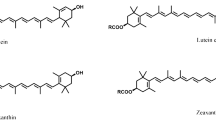Abstract
A residual mud sample from the marigold flower dehydration process was screened and 19 putative colonies were isolated for their ability to degrade lutein in a chemically defined medium supplemented with marigold flower flour as a carbon source. Among the colonies isolated, two generated volatile compounds in fermentation and one was chosen for further study for its ability to produce a strong tobacco smell. This colony contained two microorganisms, identified as Geotrichum sp. and Bacillus sp. The aroma production requires the presence of both microorganisms and lutein. Using gas chromatography coupled to mass spectrometry (GC/MS), four compounds were identified: 7,8-dihydro- β-ionol, β-ionone, 7,8-dihydro-β-ionone, and 3-hydroxy-β-ionone, in proportions of 84.2%, 9.4%, 3.5%, and 2.9%, respectively.
Similar content being viewed by others
Author information
Authors and Affiliations
Additional information
Received: 30 November 1999 / Received revision: 18 April 2000 / Accepted: 1 May 2000
Rights and permissions
About this article
Cite this article
Sánchez-Contreras, A., Jiménez, M. & Sanchez, S. Bioconversion of lutein to products with aroma. Appl Microbiol Biotechnol 54, 528–534 (2000). https://doi.org/10.1007/s002530000421
Issue Date:
DOI: https://doi.org/10.1007/s002530000421




